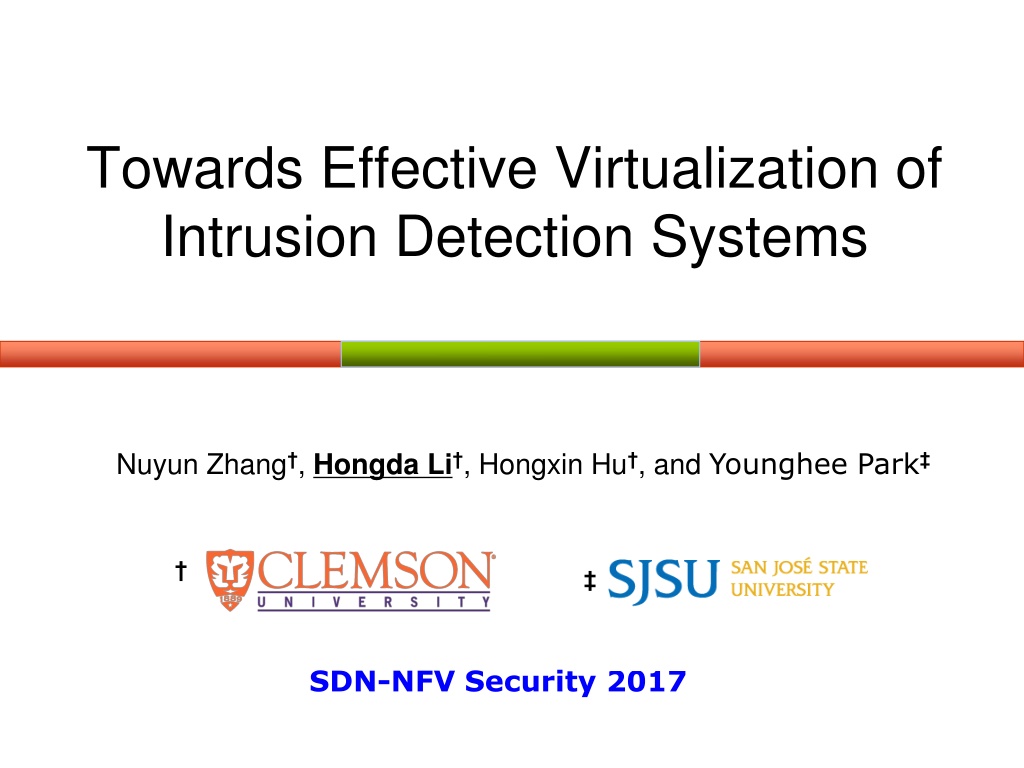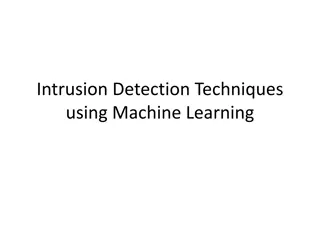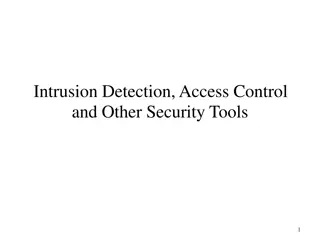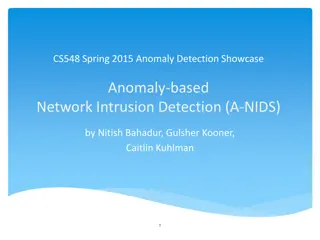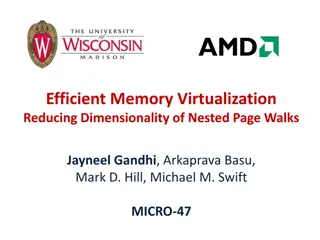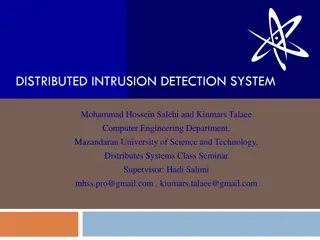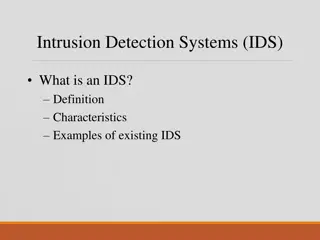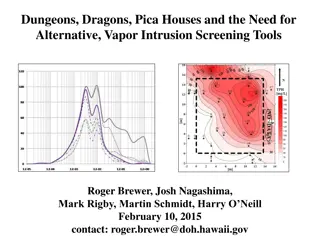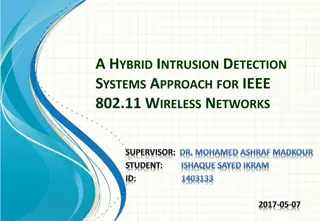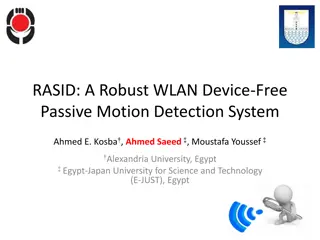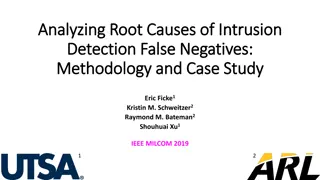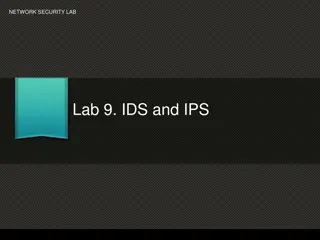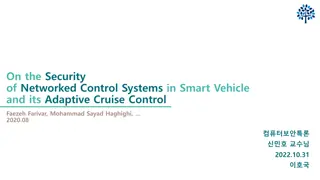Effective Strategies for Virtualizing Intrusion Detection Systems
Explore the benefits of virtualizing intrusion detection systems through microservices, addressing the limitations of traditional monolithic IDS setups. Learn how this approach improves scalability, efficiency, and customization for enhanced security measures in network environments.
Download Presentation

Please find below an Image/Link to download the presentation.
The content on the website is provided AS IS for your information and personal use only. It may not be sold, licensed, or shared on other websites without obtaining consent from the author. Download presentation by click this link. If you encounter any issues during the download, it is possible that the publisher has removed the file from their server.
E N D
Presentation Transcript
Towards Effective Virtualization of Intrusion Detection Systems Nuyun Zhang , Hongda Li , Hongxin Hu , and Younghee Park SDN-NFV Security 2017
Outline Introduction Motivations Our Approach Feasibility of our approach IDS virtualization as microservice Experiments Benefits of scaling individually Benefits of customization
Traditional IDSes Single process IDS Cannot scale to large volume of traffic Parallelization of IDS Clustered IDS: costly, fixed location/capacity Multi-core/thread IDS: fixed capacity Traditional IDSes are inflexible
Virtualized IDS Based on NFV+SDN New features Dynamically create/destroy instances Dynamically redistribute traffic Current state Split/Merge [NSDI 13] OpenNF [SIGCOMM 15] Treat virtualized IDS as monolithic piece of software
Limitations of Monolithic Virtualized IDS (1/3) Inefficient Resource Usage Available Resource Unusable Can t fit Monolithic Instance Cloud
Limitations of Monolithic Virtualized IDS (2/3) Hard Customization Customization for different purposes Monolithic Virtualized IDS Customized IDSes Knowledge of source code Error-prone Implementation-dependent
Limitations of Monolithic Virtualized IDS (3/3) Inflexible Scalability Underloaded Detector1 Detector2 Overloaded Parser Detector2 Monolithic Virtualized IDS Detector1 Scale-out Underloaded Parser Detector1 Detector2 Monolithic Virtualized IDS Parser Monolithic Virtualized IDS
Our Approach IDS Virtualiaztion as Microservice What is microservice? Breaking application into independent smaller components Components communicate through lightweight mechanisms Why microservice? Small and lightweight Scale individually Run independently
Feasibility of Our Approach Alerts, logs Run independently IDS High-level analysis Communicate via well- defined messages Per-connection, simple events Traffic Low-level per-connection parsing Low-level per-connection parsing Check-sum verification, stream reconstruction, pattern matching, etc. High-level analysis Cross-event detection tasks.
IDS Virtualization as Microservices Decomposing of virtualized IDS Low-level connection parsing service High-level attack detecting service Scheduler Detecting service1 Parsing service1 Detecting service2 Scheduler Traffic Parsing service2 Detecting service3
Efficient Resource Usage Available Resource Unusable Microservice Instances Cloud
Easy Customization Microservices Customization for different purposes Monolith Knowledge of source code Error-prone Implementation-dependent Customized IDSes User-level service composing Automation customizing Implementation-independent
Flexible Scalability Detecting service1 Parsing service1 Detecting service2 Scheduler Traffic Detecting service3 Parsing service2 Overloaded Detecting service4 Individually scaling Agility and Efficiency
Experiments Evaluate the benefits of: Scaling individually Customization Simulation No policy scripts Low-level parsing service Selective policy scripts High-level detecting service Real network traffic dataset Mid-Atlantic Collegiate Cyber Defense Competition
Benefits of Scaling Individually Microservices CPU Usage for Microservices and Monoliths
Benefits of Scaling Individually Microservices Memory Usage for Microservices and Monoliths
Benefits of Customization Bro policy scripts customization Type of traffic HTTPS Load All Customized scripts Load only HTTPS scripts Load all policy scripts HTTP Load all policy scripts Load only HTTP scripts SSH Load all policy scripts Load only SSH scripts Others Load all policy scripts Load any other scripts
Benefits of Customization CPU Usage Type of traffic HTTPS HTTP SSH Others All scripts 30.2% 29.4% 15.8% 34.2% Customized 28.1% 26.6% 15.0% 33.2% Benefits 7.1% 9.2% 4.7% 2.8% Less CPU usage Memory Usage (MB) Type of traffic All scripts Customized Benefits Less Memory usage HTTPS HTTP SSH Others 1153.5 721.0 735.0 1252.0 1027.5 636.0 654.0 1087.5 10.9% 11.8% 11.0% 13.1%
Discussion and Future Work Building Virtual IDS Security challenge: multi-step attacks Network Security as a Service FW-as-a-Service IDS-as-a-Service New security NF-as-a-Service? IoT Security Highly customizable Agility
Q & A Thank you!
Back up Limitation of our experiments Microservices Traffic volume variation
Limitations of Our Experiments Bro uses disproportional CPU in lower traffic environment. Benchmarking Pseudo realtime.bro In the future, send events to bro detector capture_events Metrics: includes memory and communication time Real data from Internet/enterprise network
Microservices vs. Monoliths Mircoservices: monitor all traffic Resource: R1 Resource: R2 Resource: R3 R3: parsing service All except HTTP scripts R1-R3: detecting service for HTTP HTTP scripts No scripts R2-R3: detecting service for non-HTTP Event Engine Event Engine Event Engine All traffic Monoliths: monitor all traffic Resource: R5 Resource: R6 Resource Usage All except HTTP scripts Microservices Monoliths HTTP scripts R3 + (R1-R3)+(R2-R3) R5+R6 Event Engine Event Engine Non-HTTP traffic HTTP traffic
Microservices Increasing concurrency and DevOps requirements Small services running in their own processes independently while communicating with each other through lightweight mechanisms Breaking an application into smaller and completely independent components, enabling each component to scale individually and be available all the time
Traffic Volume Variation Expensive option: DDoS attack on Feb. 2016 capacity peak traffic load Gbps 400 320 240 Significant Variation 160 80 0 2/19 2/22 2/25 Time Source: https://blog.cloudflare.com/a-winter-of-400gbps-weekend-ddos-attacks/
